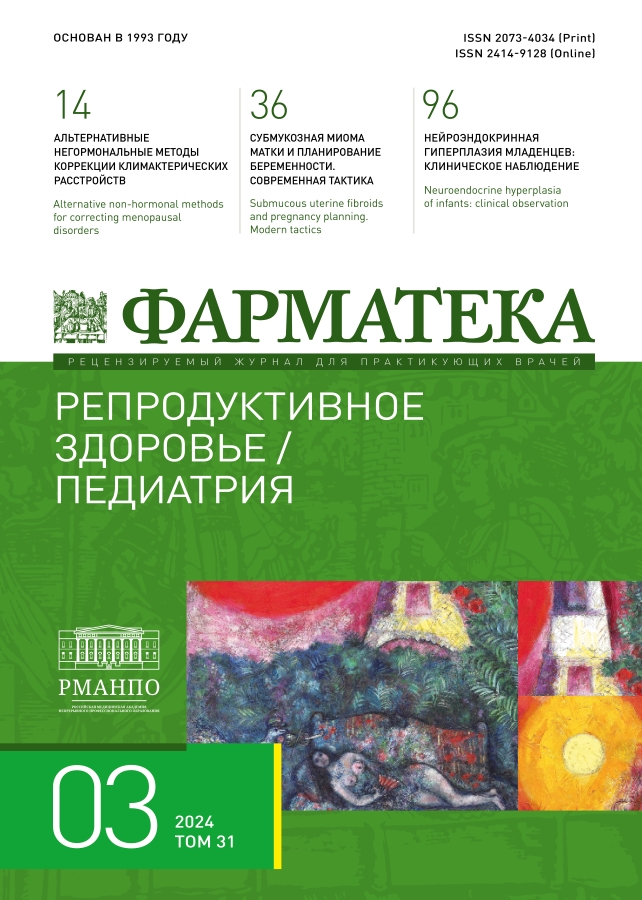Analysis of spontaneous reports of adverse drug reactions in children of different ages
- Autores: Zhdanova O.A.1, Batishcheva G.A.1, Perova N.N.1,2, Mubarakshina O.A.1, Cherenkova O.V.1, Neyno E.D.1
-
Afiliações:
- Voronezh State Medical University n.a. N.N. Burdenko
- Voronezh Regional Clinical Ophthalmological Hospital
- Edição: Volume 31, Nº 3 (2024)
- Páginas: 89-95
- Seção: Original articles
- URL: https://journals.eco-vector.com/2073-4034/article/view/634929
- DOI: https://doi.org/10.18565/pharmateca.2024.3.89-95
- ID: 634929
Citar
Texto integral
Resumo
Background. Issues related to the safety of medicines in children are one of the pressing problems in the healthcare sector. The anatomical and physiological characteristics of a child’s body, especially at an early age, increase the risk of developing adverse drug reactions (ADRs).
Objective. Analysis of adverse drug reactions in children in the Voronezh region in 2020–2022.
Methods. An analysis of notifications of ADRs in children submitted to the Regional Drug Safety Center of the Voronezh Region in 2020–2022 was carried out. The analysis was carried out by gender, patient age, type of reaction, severity, predictability of reactions; clinical manifestations and number of drugs, treatment and outcome of ADR were assessed. Statistical processing was carried out in Microsoft Excel (2017).
Results. The study included 97 cases of ADRs, 45 reports in children under 5 years of age, 21 reports in children aged 5 to 11 years, and 31 reports in adolescents over 11 years of age. ADRs were more often registered in children under 5 years of age (46.4%), predominantly in boys. The incidence of serious ADRs increased with the age of children from 33.3% in young children to 45.2% in adolescents. 66.0% of ADRs were type B, 31.9% were type A, and there were 2 (2.1%) cases of lack of therapeutic effect. Main clinical manifestations: allergic reactions – urticaria (35.1%), angioedema (15.5%), depression of the nervous system (9.3%), hepatotoxicity (8.2%). The predominant drug reactions were to antibacterial drugs (43.3%) and drugs for the treatment of diseases of the nervous system (19.6%). In adolescents, serious ADRs requiring drug therapy were more often reported. The outcome of ADR in 87.6% of patients was recovery or improvement.
Conclusion. It is necessary to promptly identify emerging ADRs on drugs in children to prevent the development of complications, reduce the severity of the current process, as well as to prevent long-term consequences.
Palavras-chave
Texto integral
Sobre autores
Olga Zhdanova
Voronezh State Medical University n.a. N.N. Burdenko
Autor responsável pela correspondência
Email: olga.vr9@yandex.ru
ORCID ID: 0000-0002-3917-0395
Dr. Sci. (Med.), Associate Professor, Professor at the Department of Clinical Pharmacology
Rússia, VoronezhG. Batishcheva
Voronezh State Medical University n.a. N.N. Burdenko
Email: olga.vr9@yandex.ru
ORCID ID: 0000-0003-4771-7466
Rússia, Voronezh
N. Perova
Voronezh State Medical University n.a. N.N. Burdenko; Voronezh Regional Clinical Ophthalmological Hospital
Email: olga.vr9@yandex.ru
Código SPIN: 8327-0100
Rússia, Voronezh; Voronezh
O. Mubarakshina
Voronezh State Medical University n.a. N.N. Burdenko
Email: olga.vr9@yandex.ru
ORCID ID: 0000-0001-6799-6322
Rússia, Voronezh
O. Cherenkova
Voronezh State Medical University n.a. N.N. Burdenko
Email: olga.vr9@yandex.ru
ORCID ID: 0000-0001-5320-2720
Rússia, Voronezh
E. Neyno
Voronezh State Medical University n.a. N.N. Burdenko
Email: olga.vr9@yandex.ru
ORCID ID: 0009-0004-6694-7245
Rússia, Voronezh
Bibliografia
- Cliff-Eribo K.O., Sammons H., Choonara I. Systematic review of paediatric studies of adverse drug reactions from pharmacovigilance databases. Expert Opin Drug Saf. 2016;15(10):1321–28. doi: 10.1080/14740338.2016.1221921.
- Титова А.Р., Асецкая И.Л., Поливанов В.А. и др. Исследование безопасности применения лекарственных препаратов у детей в Российской Федерации: анализ национальной базы данных спонтанных сообщений. Вестник Росздравнадзора. 2016;3:62–73. [Titova A.R., Asetskaya I.L., Polivanov V.A., et al. A study of safe drug use in children in the Russian Federation: a review of the national spontaneous reporting database. Vestnik Roszdravnadzor. 2016;3:62–73. (In Russ.)].
- Star K., Noren G.N., Nordin K., et al. Suspected Adverse Drug Reactions Reported For Children Worldwide. Drug Saf. 2011;34;415–28. doi: 10.2165/11587540-000000000-00000.
- Литвиненко Т.С., Сафроненко А.В., Ганцгорн Е.В. и др. Нежелательные лекарственные реакции и методические подходы к их мониторингу. Биомедицина. 2021;17(3):56–61. doi: 10.33647/2074-5982-17-3-56-61. [Litvinenko T.S., Safronenko A.V., Gantsgorn E.V., et al. Adverse Drug Reactions and Methodological Approaches to Their Monitoring. J Biomed. 2021;17(3):56–61. (In Russ.)].
- Meyboom R.H., Lindquist M., Egberts A.C. An ABC of drug-related problems. Drug Saf. 2000;22(6):415–23. doi: 10.2165/00002018-200022060-00001.
- Kaufman G. Adverse drug reactions: classification, susceptibility and reporting. Nurs Stand. 2016;30(50):53–63. doi: 10.7748/ns.2016.e10214.
- Edwards, I.R., Aronson J.K. Adverse drug reactions: definitions, diagnosis, and management. Lancet 2000;356:1255-9.
- Schatz S. Weber R. Adverse drug reactions. Pharm Pract. 2015;1:5–26.
- Елисеева Т.И., Туш Е.В., Балаболкин И.И. и др. Неблагоприятные реакции на лекарственные средства у детей. Фарматека. 2017;11(344):22–7. [Eliseeva T.I., Tush E.V., Balabolkin I.I., et al. Adverse drug reactions in children. Farmateka. 2017;11(344):22–7. (In Russ.)].
- Aurich B., Apele-Freimane D., Banaschewski T., et al. Paediatric pharmacovigilance: Methodological considerations in research and development of medicines for children – A c4c expert group white paper. Br J Clin Pharmacol. 2022;88(12):4997–5016. doi: 10.1111/bcp.15119.
- Leporini C., De Sarro C., Palleria C., et al. Pediatric Drug Safety Surveillance: A 10-Year Analysis of Adverse Drug Reaction Reporting Data in Calabria, Southern Italy. Drug Saf. 2022;45(11): 1381–402. doi: 10.1007/s40264-022- 01232-w.
- Lima E.D.C., Matos G.C., Vieira J.M.L., et al. Suspected adverse drug reactions reported for Brazilian children: cross-sectional study. J Pediatr. (Rio J). 2019;95(6):682–88. doi: 10.1016/j.jped.2018.05.019.
Arquivos suplementares











